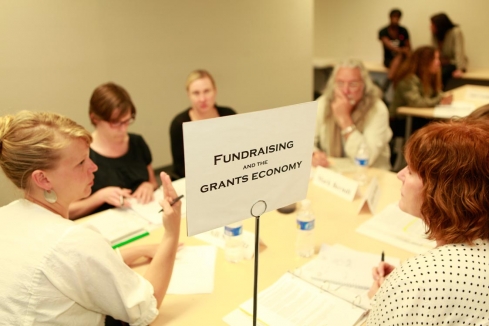Natural Cultural Districts: A Three-City Study
Social Impact of the Arts Project (SIAP), University of Pennsylvania: Mark Stern, Susan Seifert
This report examines three naturally occurring cultural districts (NOCDs) in Baltimore, Philadelphia, and Seattle. All three cities appear to be experiencing a decrease in the size and strength of medium-sized nonprofit organizations, but the process is most obvious in Seattle, which is dominated by extremes: large, established cultural organizations and a proliferation of many smaller entities, many of which are for-profit. The research also explores how the growth of the informal cultural sector—artists who are neither incorporated nonprofits nor commercial firms—is rapidly changing the character of neighborhood cultural districts in Philadelphia and Baltimore. The findings suggest that the key to building successful cultural communities is to examine the ecology in which individual organizations and artists operate, rather than viewing them in isolation.
Extracts
From 2010 to 2012, with LINC support, the Social Impact of the Arts Project (SIAP) at the University of Pennsylvania undertook a study of “natural” cultural districts in Baltimore, Philadelphia, and Seattle.
SIAP developed the concept of a “natural cultural district” as a way to rethink the relationship of the arts and culture to neighborhood development. Instead of beginning with a particular organization or project, “natural” cultural districts view community revitalization through the lens of the community cultural ecosystem.
SIAP research has demonstrated that concentrations of cultural assets (including nonprofits, businesses, and resident artists) are a reliable indicator of neighborhood revitalization. Cultural clusters improve the chance that a neighborhood will see its poverty rate decline and it population increase. They reinforce ethnic and economic diversity. They stimulate social network formation both within and across neighborhoods. These social networks are the critical mechanism for translating cultural assets into social and economic regeneration.
In all three cities, the social impact of the arts is caught in two cross-cutting currents, but the nature of those currents varies with the context. The two currents are social inequality and diversity. None of the cities can resist the broad national and international explosion in inequality, although its effects can be mitigated to some extent through economic growth. Diversity is more complicated. Although three dimensions of diversity—economic, ethnic, and household—are present in all three cities, their prevalence and interactions vary.
One surprise of the project has been the varied relationships between social geography and cultural ecology across the three cities. Only two factors—distance from downtown and household diversity—played significant roles in all three cities. We expected socioeconomic status—which is so important in Philadelphia—to play a prominent role across cities, but this was not the case in Seattle, where the richest neighborhoods did not have the highest cultural asset scores. The same contrast between the eastern cities and Seattle held for the relationship of cultural resources to educational attainment, occupational status, and poverty.
The study proposed two ways of viewing “natural” cultural districts—by their cultural ecology and by their socio-economic and location advantage. [ … ] Where cultural ecology provides a means of understanding the internal development of neighborhood clusters, the social geography analysis allows us to understand how cultural assets influence community well-being in the context of inequality and exclusion. We can differentiate districts into those that succeed in the context of social advantage—high market and market districts—from those that must overcome legacies of exclusion and discrimination—civic clusters. This typology focuses our attention on the social and economic benefits of cultural engagement and on the challenges to the achievement of cultural equity. Overall, the concentration of cultural assets in a neighborhood is associated with declining poverty in 2000 and from 2005-2009, even when we control for per capita income in 2000. All three types of “natural” cultural districts carry with them a set of social benefits, including higher rates of social diversity, improved public health outcomes, and declines in ethnic and racial harassment. [ . . . ] Unfortunately, for civic clusters, the considerable social benefits of cultural districts do not translate into economic benefits for the residents. [ . . . ] This gap between the social and economic benefits of civic districts poses one the most significant challenges for the translation of cultural policy into social policy.
One of the findings of our project has been that the trends affecting the cultural world in general have a specific set of spatial effects. Here, we focus on their implications for developing and managing cultural spaces. Conventionally, issues about cultural space have been tied to the viability of cultural organizations. Established cultural organizations typically raised the funding and managed their own spaces. Although there are many examples of how this process diverted organizations from their central mission, developing its own facility was a way for an organization to demonstrate that it had arrived. Yet, in a world in which established cultural organizations have become an endangered species, the idea of one organization/one space no longer seems viable or even desirable. Increasingly, this suggests a separation of the tasks of developing and managing spaces and the withdrawal of most cultural organizations and projects from involvement in either.
One surprise that has emerged from this study has been the degree to which art and culture are divorced at the community level. [. . .] Although arts funders have continued to support cultural equity, their focus tends to be on diversifying elite cultural institutions rather than feeding the grassroots. Meanwhile, the changing demographics of our cities are changing what these grassroots look like.
In conclusion, we found that the two forces—increasing inequality and increasing diversity—influence the trajectory of the arts and culture in all three cities, albeit in different ways. We doubt if both trends are sustainable. Indeed, it appears to some extent that inequality has been killing off diversity. Whether they both can survive, or if not, which will survive is a dilemma for the arts—and for society as a whole.

